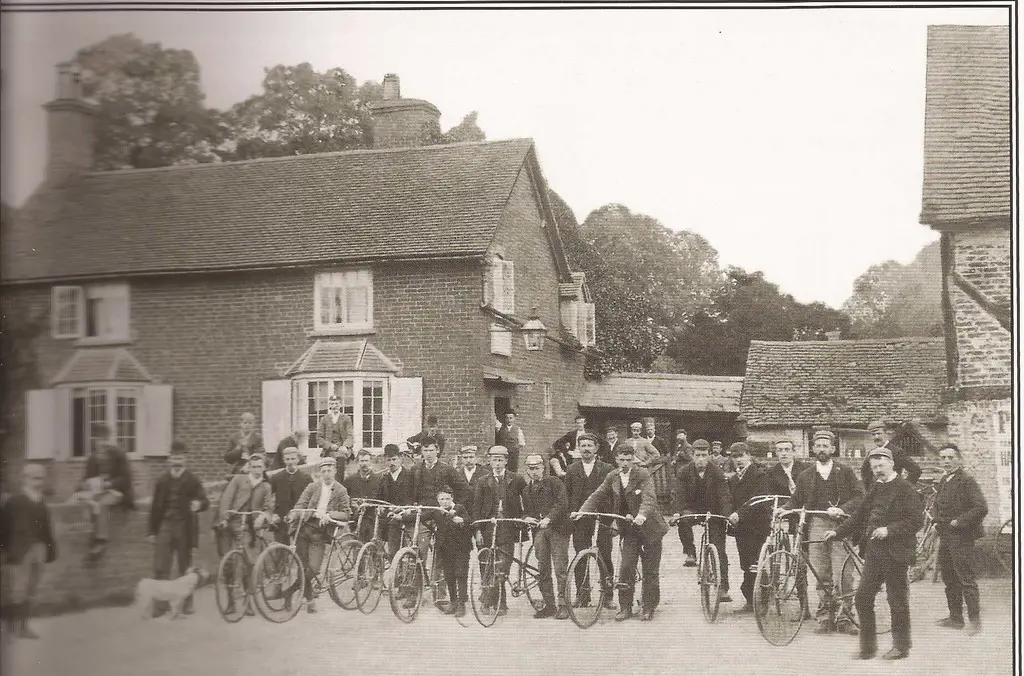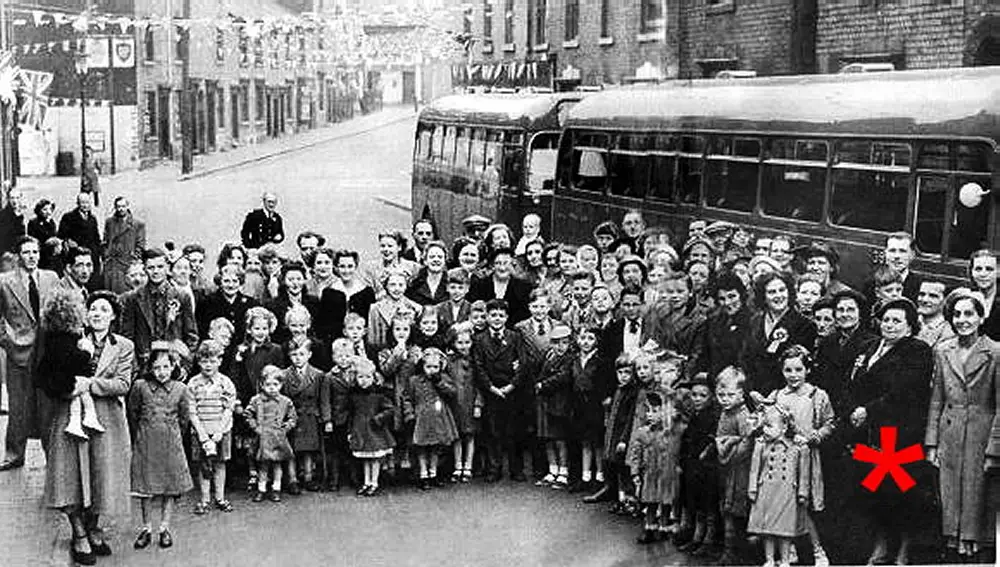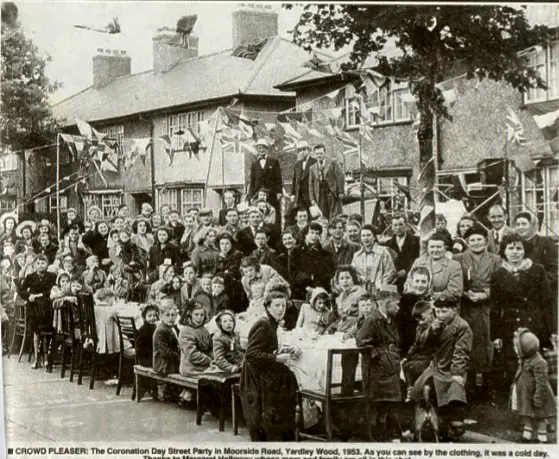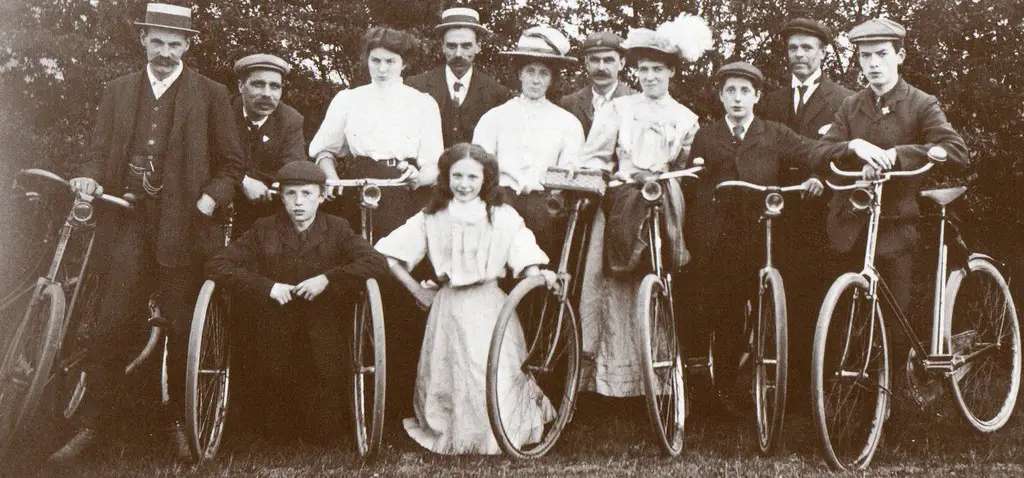-
Welcome to this forum . We are a worldwide group with a common interest in Birmingham and its history. While here, please follow a few simple rules. We ask that you respect other members, thank those who have helped you and please keep your contributions on-topic with the thread.
We do hope you enjoy your visit. BHF Admin Team
You are using an out of date browser. It may not display this or other websites correctly.
You should upgrade or use an alternative browser.
You should upgrade or use an alternative browser.
Group photos
- Thread starter Anne Jessel
- Start date
paul stacey
master brummie
I love to look at these old photo's, and imagine who the people all were and how they worked and lived. I am glad you have fond memories of Cambridge Old Mohawk. Paul
oldMohawk
gone but not forgotten
Hi Willey, I know what you mean about university life. I put other photos from that course in a forum post here
https://birminghamhistory.co.uk/forum/showthread.php?t=19580&p=152393#post152393
oldmohawk
https://birminghamhistory.co.uk/forum/showthread.php?t=19580&p=152393#post152393
oldmohawk
cookie273uk
Gone but not forgotten
Two great group photos Phil and Eric. Was wondering if the photos were taken at the start of training or at the end? There are 6 years between the two photos and wonder if you both went through the same training. Were they all National Service men? Viv.
Last edited:
oldMohawk
gone but not forgotten
Hi Viv, I was conscripted into National Service and my photo was taken during basic training when I had probably been in the RAF for 7 weeks. The are many posts in the 'military part' of the forum and my first briefly summed up my RAF experience in one post here ...
https://birminghamhistory.co.uk/forum/index.php?threads/national-service.513/page-4#post-69015
I went on to put another 116 posts in the National Service thread ....

Phil
https://birminghamhistory.co.uk/forum/index.php?threads/national-service.513/page-4#post-69015
I went on to put another 116 posts in the National Service thread ....
Phil
Last edited:
cookie273uk
Gone but not forgotten
 Hi Vivienne, Phil would have been a national serviceman completing his 2 months basic training at Padgate where the National service men went, I was a regular (1948 to 1956) and regulars completed their 3 months basic training at Cardington (home of the tragic 101 airship). I went on to become an aircrew wireless operator, my first posting 2 years in Africa on 82 (PR) Squadron, the last Lancaster Squadron in the RAF, I logged just under 5,000 hours on Lancasters. Happy days. Eric
Hi Vivienne, Phil would have been a national serviceman completing his 2 months basic training at Padgate where the National service men went, I was a regular (1948 to 1956) and regulars completed their 3 months basic training at Cardington (home of the tragic 101 airship). I went on to become an aircrew wireless operator, my first posting 2 years in Africa on 82 (PR) Squadron, the last Lancaster Squadron in the RAF, I logged just under 5,000 hours on Lancasters. Happy days. Eric
Last edited:
Smashing photos Phil, Eric and Mickymoo. Good to hear your memories behind the photos. My dad (ex-RAF flight engineer in WW2) would have dearly loved to have stayed in the RAF but was medically retired. I get a sense of why he loved it from both Phil's and Eric's memories. He went on cadet training to Rhyl, but this must have been in the 1930s. And I know he went to Cambridge too for some training, although have no details.
Mickymoo, pity you didn't get your stripe but do post memories relating to the photo if anything else comes to mind. Interesting to find out any background to these. Viv.
Mickymoo, pity you didn't get your stripe but do post memories relating to the photo if anything else comes to mind. Interesting to find out any background to these. Viv.
Last edited:
oldMohawk
gone but not forgotten
A group of cyclists outside the Three Horseshoes in Sheldon. No lady cyclists in the group that day.

The pic is in a forum post https://birminghamhistory.co.uk/for...ught-in-our-old-street-pics.41947/post-545981

The pic is in a forum post https://birminghamhistory.co.uk/for...ught-in-our-old-street-pics.41947/post-545981
Last edited:
paul stacey
master brummie
I very much doubt that women would cycle at this time, quite a bit later I would think, early 1900's maybe, great picture though. Paul
Probably a cycling club. They flourished in the inter-war period, although as Paul says, the photo could be earlier. It gave working class men a sense of freedom and fellowship. And all sorts of cycling groups were formed such as religious or works groups. Many in the photo seem to be wearing a particular type of cap, maybe it was the club cap. Lovely photo. Viv.
Last edited:
norfolk brummie
gone but not forgotten
Eddie, your grandfather's cycling group seem to be celebrating something; many are wearing buttonhole flowers, the man next to your grandfather is wearing, I think, a medal. So I imagine it might have been some sort of celebration. Quite a few gentlemen are older in the photo so maybe not all were cyclists.
Phil, yes skirts must have been a hazard. I think women cyclists started to wear plus fours, but later than your photo.
This cycling group photo is of the founders of the Clarion Cycling club, formed in 1894 in Birmingham by a group of like-minded enthusiasts of the Park Lane Labour Church.

Some background info about the club. Viv.
Phil, yes skirts must have been a hazard. I think women cyclists started to wear plus fours, but later than your photo.
This cycling group photo is of the founders of the Clarion Cycling club, formed in 1894 in Birmingham by a group of like-minded enthusiasts of the Park Lane Labour Church.

Some background info about the club. Viv.
Attachments
Last edited:
And a little background history about the Labour Church from British History Online. Viv.
"Birmingham Labour Church, in connexion with the Labour Church Union, was founded in 1893, and from 1894 to 1897 occupied Bond Street chapel, formerly a Baptist and a Methodist place of worship. (fn. 1024) Fifty members were present at a meeting in 1894. In 1897 the church moved to Oozells Street Board School, and in the following year to Bristol Street Board School, where it continued for some years; in 1900 a membership of 100 and an average attendance of 80 were claimed. (fn. 1025) The title of the body was changed in 1909 to Birmingham Socialist Church. The church was dissolved shortly after the outbreak of the First World War. Another 'labour church' existed at Stirchley at least from 1911 to 1913 and probably for a longer period. (fn. 1026) Throughout the congregation's history two tendencies existed among the members: agnosticism and an illdefined Christian socialism. Tom Groom, for many years secretary of the church, was a former member of the Guild of St. Matthew, the Anglican socialist order founded by Stewart Headlam. (fn. 1027) The Birmingham Church did not subscribe to the five articles on which the national church was based, and required of its members only 'adhesion to the moral and economic laws that may be adduced from the Fatherhood of God or the Brotherhood of Man'. (fn. 1028) At the same time it adopted religious forms, holding regular Sunday evening services, and publishing a hymnal in several editions. In 1899 J. A. Fallows, formerly a minister of the Church of England, became secretary. (fn. 1029) Fallows was also secretary of the Socialist Centre, and there were other links with the political labour movement. In 1895 the Labour Church combined with the Birmingham Fabian Society to found the Socialist Lecture Committee, and in 1901 it took part in the formation of the Birmingham Labour Representation Council. In 1909 the church was described by its committee as 'the common meeting ground of men and women representing all sections of the socialist movement'. (fn. 1030)
A subsidiary youth organization, the 'Cinderella Club', was said to have been founded by Robert Blatchford in 1893, (fn. 1031) and as the 'Clarion Cinderella Club' it survived the Labour Church. (fn. 1032) It was explicitly non-political and devoted itself to treats and excursions for poor children, and similar social and charitable work. For several years the club conducted a holiday cottage for crippled children outside Birmingham. (fn. 1033) The first Clarion Cycling Club was formed at a meeting of the Birmingham church in 1894. (fn. 1034)"
"Birmingham Labour Church, in connexion with the Labour Church Union, was founded in 1893, and from 1894 to 1897 occupied Bond Street chapel, formerly a Baptist and a Methodist place of worship. (fn. 1024) Fifty members were present at a meeting in 1894. In 1897 the church moved to Oozells Street Board School, and in the following year to Bristol Street Board School, where it continued for some years; in 1900 a membership of 100 and an average attendance of 80 were claimed. (fn. 1025) The title of the body was changed in 1909 to Birmingham Socialist Church. The church was dissolved shortly after the outbreak of the First World War. Another 'labour church' existed at Stirchley at least from 1911 to 1913 and probably for a longer period. (fn. 1026) Throughout the congregation's history two tendencies existed among the members: agnosticism and an illdefined Christian socialism. Tom Groom, for many years secretary of the church, was a former member of the Guild of St. Matthew, the Anglican socialist order founded by Stewart Headlam. (fn. 1027) The Birmingham Church did not subscribe to the five articles on which the national church was based, and required of its members only 'adhesion to the moral and economic laws that may be adduced from the Fatherhood of God or the Brotherhood of Man'. (fn. 1028) At the same time it adopted religious forms, holding regular Sunday evening services, and publishing a hymnal in several editions. In 1899 J. A. Fallows, formerly a minister of the Church of England, became secretary. (fn. 1029) Fallows was also secretary of the Socialist Centre, and there were other links with the political labour movement. In 1895 the Labour Church combined with the Birmingham Fabian Society to found the Socialist Lecture Committee, and in 1901 it took part in the formation of the Birmingham Labour Representation Council. In 1909 the church was described by its committee as 'the common meeting ground of men and women representing all sections of the socialist movement'. (fn. 1030)
A subsidiary youth organization, the 'Cinderella Club', was said to have been founded by Robert Blatchford in 1893, (fn. 1031) and as the 'Clarion Cinderella Club' it survived the Labour Church. (fn. 1032) It was explicitly non-political and devoted itself to treats and excursions for poor children, and similar social and charitable work. For several years the club conducted a holiday cottage for crippled children outside Birmingham. (fn. 1033) The first Clarion Cycling Club was formed at a meeting of the Birmingham church in 1894. (fn. 1034)"
Last edited:
norfolk brummie
gone but not forgotten
Eddie, your grandfather's cycling group seem to be celebrating something; many are wearing buttonhole flowers, the man next to your grandfather is wearing, I think, a medal. So I imagine it might have been some sort of celebration. Quite a few gentlemen are older in the photo so maybe not all were cyclists.
Isn't it amazing. All these years I have only ever really looked at my Grand Father, and the group in general. Never noticed the medal, or the buttonholes. Many, many thanks, Viv.
It does state on the rear of the 'photo: "KINGS HEATH CYCLING CLUB", but no further details. I wonder what the occasion was?
Eddie.
oldMohawk
gone but not forgotten
Plenty of flags out for the Queen's Coronation as another group pose in this photo on the forum.
It is amongst a collection which Lyn scanned in 2009 from some old Evening Mails see them here.
https://birminghamhistory.co.uk/for...d-evening-mail-pics.21690/page-16#post-422536
The reason for the red star is explained in a post here
https://birminghamhistory.co.uk/for...ld-evening-mail-pics.21690/page-2#post-180894

It is amongst a collection which Lyn scanned in 2009 from some old Evening Mails see them here.
https://birminghamhistory.co.uk/for...d-evening-mail-pics.21690/page-16#post-422536
The reason for the red star is explained in a post here
https://birminghamhistory.co.uk/for...ld-evening-mail-pics.21690/page-2#post-180894

Last edited:
How amazing that they went on coach trips in 1953 to view all the other street decorations. Simple pleasures. By this time hats seem to have become less common for men and women than in the 1940s. I remember those coats for girls, they weren't very comfy and were made of coarse wool. Everyone looks nicely turned out for the trip. And not one, but two coaches! Wondering if that's a garage to the left - the sign looks like a 'BP' sign. So maybe the various street residents congregated outside the garage for their trip. Viv.
Here we have a lovely group photo of Pearl Assurance staff (Saltley) in 1914. How thoughtful of Pearl Assurance to include spouses and their employees children in the photo. (Well I'm assuming the women with babies on their laps are spouses of employees). But there's an intriguing OXO thingy on the front row. Any ideas? Googled it but can't find anything like it. Doubt it's a toy. Viv.


Re US servicemen in post #34 makes we wonder what effect all those servicemen had on the local area. Having more cash in their pockets than most local people, I expect they'd have been a welcome boost to businesses. Or did they put even more pressure on already limited supplies ?
Re Cavendush Road. Such happy faces. It's just struck me that early lives of all those in the photo would have been dominated by WW2. And for the very young, they wouldn't have experienced peacetime. The boy far left at the back is wearing something with 'Ration.....' printed on it. Do you know what that was? Viv.
Re Cavendush Road. Such happy faces. It's just struck me that early lives of all those in the photo would have been dominated by WW2. And for the very young, they wouldn't have experienced peacetime. The boy far left at the back is wearing something with 'Ration.....' printed on it. Do you know what that was? Viv.
Last edited:
oldMohawk
gone but not forgotten
Hi Viv - As a very young child in WW2 I probably met some of the servicemen in that photo. They did make quite an impact on the district. When they often visited families they brought food like we had never seen before, and of course they visited the local pubs. There is one story about them hereRe US servicemen in post #34 makes we wonder what effect all those servicemen had on the local area. Having more cash in their pockets than most local people, I expect they'd have been a welcome boost to businesses. Or did they put even more pressure on already limited supplies ?
Viv.
https://birminghamhistory.co.uk/forum/showthread.php?t=4180&p=83144#post83144
oldMohawk
gone but not forgotten
Hi Viv - He is dressed up as a ration book which were very familiar items in those days. My brother-in-law is in that pic and I will ask him about it when I see him tomorrow. Most of the children in the pic would have spent nights in air raid shelters during the early part of WW2 and still had to go to school next morning.Re Cavendush Road. Such happy faces. It's just struck me that early lives of all those in the photo would have been dominated by WW2. And for the very young, they wouldn't have experienced peacetime. The boy far left at the back is wearing something with 'Ration.....' printed on it. Do you know what that was? Viv.
The 'ration book' costume on the left was drawn on brown paper, and the letters on the hat were something to do with the Birmingham Food Office but my brother-in-law can't remember what they were. Even though rationing was strict particularly in the early years of the war, the children look well nourished.
Last edited:
oldMohawk
gone but not forgotten
I suppose June 1953 was in a good year for group photos of street parties never forgotten ...Coronation Day June 1953 was cold and breezy, but nothing was going to stop these 'Brummies' in Moorside Rd Yardley Wood having a street party even if overcoats and raincoats had to be worn.







